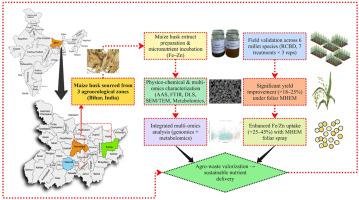将玉米壳渣转化为多组学验证的生物刺激剂:维持小米微量营养素输送的农业废物生物制剂
IF 5.8
2区 生物学
Q1 AGRICULTURAL ENGINEERING
引用次数: 0
摘要
耕地土壤普遍缺乏铁和锌,损害了作物的生产性能和营养,而农业废弃物的回收利用为传统肥料提供了一种具有成本效益和生物可利用性的替代品。本研究探索了利用多组学方法转化玉米废料作为稳定铁和锌的生物活性物质的方面。玉米皮提取物与2.5% Fe - Zn溶液孵化导致游离元素水平降低(Fe: 11,250 mg L - 1; Zn: 12,300 mg L - 1),在原子吸收光谱中表现出成功的微量营养素络合。动态光散射显示,与商业微量营养素(~ 2000 nm)相比,MHE孵育将颗粒尺寸减小到~ 300-600 nm,并改善了均匀性。扫描电子显微镜和透射电子显微镜进一步揭示了均匀的球形颗粒嵌入玉米外壳,证实了微量营养素的成功稳定。傅里叶变换红外光谱分析表明,螯合官能团(-OH, -COOH)增强,代谢组学分析显示,作为关键螯合剂的柠檬酸(RT ~ 12.3 min)、苹果酸(RT ~ 15.6 min)和没食子酸(RT ~ 21.4 min)富集约2倍。宏基因组分析发现,产铁载体的糙孢链霉菌(0.31%)和无松假单胞菌(0.52%)是有机酸生物合成和微量营养素动员的主要贡献者。随后对6种谷子作物进行的田间试验证实,基于mhed的叶面配方显著提高了铁和锌的吸收(25 - 45%),并使谷子产量提高了25%,尤其是谷子和珍珠谷子,从而验证了这种废物衍生创新的生物利用度和农艺效益。这些发现证实了MHE是一种生态友好型生物刺激素,可以提高微量营养素的生物利用度,同时使农业废物增值,促进可持续农业。本文章由计算机程序翻译,如有差异,请以英文原文为准。

Bio-transforming maize husk residue into a multi-omics-validated biostimulant: Agro-waste bioformulation sustaining micronutrient delivery in millets
Widespread iron and zinc deficiencies in cultivated soils impair crop performance and nutrition, while agro-waste recycling offers a cost-effective and bioavailable alternative to conventional fertilizers. Present study explored the aspect of transforming maize husk derived extract as a bioactive material for stabilizing Fe and Zn using a validated multi-omics approach to transform maize waste in bio-input. Maize husk extract incubation with 2.5 % Fe–Zn solution led to reduced levels of free elements (Fe: 11,250 mg L−1; Zn: 12,300 mg L−1) presenting successful micronutrient complexation in Atomic Absorption Spectroscopy. Dynamic Light Scattering revealed that, against the commercial micronutrient (∼2000 nm), MHE incubation reduced particle size to ∼300–600 nm with improved uniformity. Scanning Electron and Transmission Electron Microscopy further revealed uniform spherical particles embedded within the maize husk, confirming successful micronutrient stabilization. Fourier Transform Infrared Spectroscopy analysis indicated intensified chelating functional groups (–OH, –COOH), and metabolomic profiling showed ∼2-fold enrichment of citric (RT ∼12.3 min), malic (RT ∼15.6 min), and gallic acids (RT ∼21.4 min), acting as key chelators. Metagenomic analysis identified siderophore-producing Streptomyces scabrisporus (0.31 %) and Pseudomonas umsongensis (0.52 %) as dominant contributors to organic acid biosynthesis and micronutrient mobilization. Subsequent field trials with six millet crops confirmed that MHE-based foliar formulations significantly enhanced Fe and Zn uptake (25–45 %) and increased grain yield by up to 25 %, especially in foxtail and pearl millet, validating the bioavailability and agronomic efficacy of this waste-derived innovation. These findings validate MHE as an ecofriendly biostimulant that improves micronutrient bioavailability while valorizing agro-waste for sustainable agriculture.
求助全文
通过发布文献求助,成功后即可免费获取论文全文。
去求助
来源期刊

Biomass & Bioenergy
工程技术-能源与燃料
CiteScore
11.50
自引率
3.30%
发文量
258
审稿时长
60 days
期刊介绍:
Biomass & Bioenergy is an international journal publishing original research papers and short communications, review articles and case studies on biological resources, chemical and biological processes, and biomass products for new renewable sources of energy and materials.
The scope of the journal extends to the environmental, management and economic aspects of biomass and bioenergy.
Key areas covered by the journal:
• Biomass: sources, energy crop production processes, genetic improvements, composition. Please note that research on these biomass subjects must be linked directly to bioenergy generation.
• Biological Residues: residues/rests from agricultural production, forestry and plantations (palm, sugar etc), processing industries, and municipal sources (MSW). Papers on the use of biomass residues through innovative processes/technological novelty and/or consideration of feedstock/system sustainability (or unsustainability) are welcomed. However waste treatment processes and pollution control or mitigation which are only tangentially related to bioenergy are not in the scope of the journal, as they are more suited to publications in the environmental arena. Papers that describe conventional waste streams (ie well described in existing literature) that do not empirically address ''new'' added value from the process are not suitable for submission to the journal.
• Bioenergy Processes: fermentations, thermochemical conversions, liquid and gaseous fuels, and petrochemical substitutes
• Bioenergy Utilization: direct combustion, gasification, electricity production, chemical processes, and by-product remediation
• Biomass and the Environment: carbon cycle, the net energy efficiency of bioenergy systems, assessment of sustainability, and biodiversity issues.
 求助内容:
求助内容: 应助结果提醒方式:
应助结果提醒方式:


